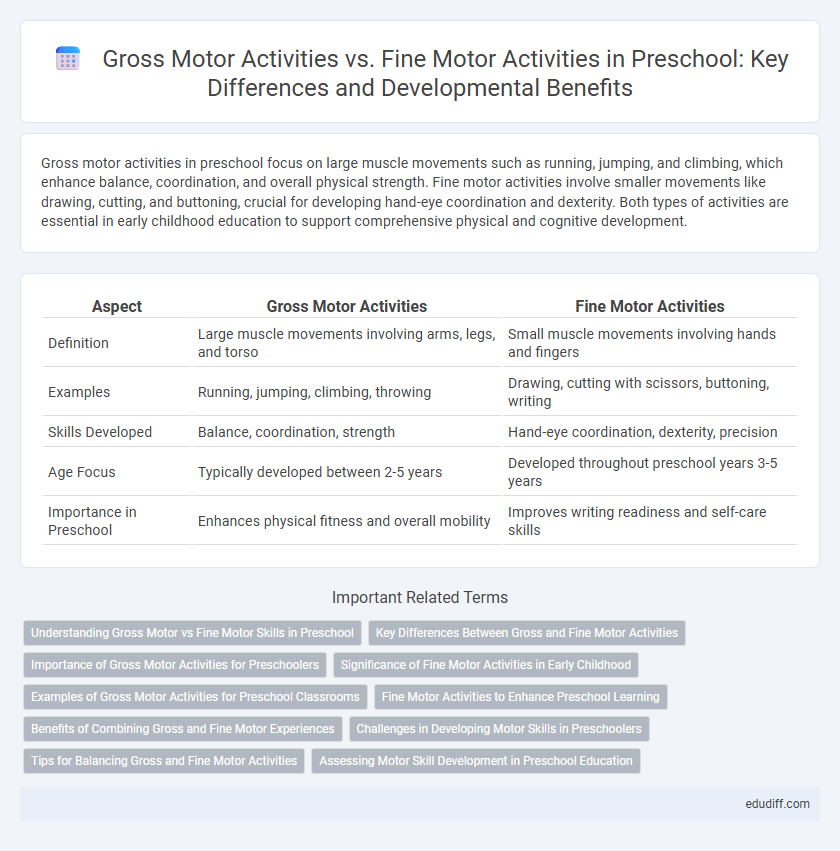Gross motor activities in preschool focus on large muscle movements such as running, jumping, and climbing, which enhance balance, coordination, and overall physical strength. Fine motor activities involve smaller movements like drawing, cutting, and buttoning, crucial for developing hand-eye coordination and dexterity. Both types of activities are essential in early childhood education to support comprehensive physical and cognitive development.
Table of Comparison
| Aspect | Gross Motor Activities | Fine Motor Activities |
|---|---|---|
| Definition | Large muscle movements involving arms, legs, and torso | Small muscle movements involving hands and fingers |
| Examples | Running, jumping, climbing, throwing | Drawing, cutting with scissors, buttoning, writing |
| Skills Developed | Balance, coordination, strength | Hand-eye coordination, dexterity, precision |
| Age Focus | Typically developed between 2-5 years | Developed throughout preschool years 3-5 years |
| Importance in Preschool | Enhances physical fitness and overall mobility | Improves writing readiness and self-care skills |
Understanding Gross Motor vs Fine Motor Skills in Preschool
Gross motor activities in preschool focus on large muscle groups, enhancing skills such as running, jumping, and climbing that develop coordination and balance. Fine motor activities target small muscle movements essential for tasks like writing, cutting, and buttoning, supporting hand-eye coordination and dexterity. Understanding the distinction between gross motor and fine motor skills enables educators to design age-appropriate activities that promote overall physical development in young children.
Key Differences Between Gross and Fine Motor Activities
Gross motor activities involve large muscle groups for movements like running, jumping, and climbing, essential for overall physical development and coordination in preschool children. Fine motor activities focus on small muscle movements, particularly in the hands and fingers, crucial for skills such as writing, buttoning clothes, and manipulating small objects. Understanding the distinction helps educators tailor activities that support both gross motor skills for mobility and fine motor skills for precision and hand-eye coordination in early childhood development.
Importance of Gross Motor Activities for Preschoolers
Gross motor activities play a critical role in preschoolers' physical development by enhancing large muscle strength, coordination, and balance, essential for daily tasks and overall health. These activities, such as running, jumping, and climbing, promote cardiovascular fitness and improve spatial awareness, which supports cognitive growth and social interaction. Incorporating consistent gross motor play in preschool settings fosters children's confidence and sets the foundation for advanced motor skills needed in later childhood.
Significance of Fine Motor Activities in Early Childhood
Fine motor activities in early childhood are essential for developing hand-eye coordination, dexterity, and precise muscle control critical for writing, drawing, and self-care skills. These activities enhance neural connections in the brain, supporting cognitive development and school readiness. Prioritizing fine motor skills helps children build confidence and independence, laying the foundation for academic success and daily life tasks.
Examples of Gross Motor Activities for Preschool Classrooms
Gross motor activities in preschool classrooms include running, jumping, climbing, and throwing, which help develop large muscle groups essential for overall physical coordination and strength. Activities such as obstacle courses, hopping on one foot, and playing with balls promote balance and agility, critical for early childhood development. Incorporating these movements daily supports children's motor skills, spatial awareness, and confidence in physical abilities.
Fine Motor Activities to Enhance Preschool Learning
Fine motor activities in preschool, such as drawing, cutting with scissors, and manipulating small objects, significantly enhance children's hand-eye coordination and dexterity. These tasks promote cognitive development by improving focus, problem-solving skills, and the ability to perform complex tasks requiring precision. Prioritizing fine motor skills lays a strong foundation for writing, self-care, and academic success in early childhood education.
Benefits of Combining Gross and Fine Motor Experiences
Combining gross motor activities like jumping and running with fine motor tasks such as drawing or buttoning enhances preschoolers' overall physical development by improving coordination, balance, and dexterity. This integrated approach supports brain development, strengthening neural connections that facilitate both large and small muscle control. Engaging in diverse motor experiences also boosts self-confidence and promotes cognitive skills like problem-solving and focus.
Challenges in Developing Motor Skills in Preschoolers
Preschoolers often face challenges in developing gross motor skills such as balance, coordination, and strength necessary for activities like running, jumping, and climbing, which require whole-body movement and spatial awareness. Fine motor skill development involves mastering precise hand and finger movements for tasks like cutting with scissors, buttoning clothes, and drawing shapes, presenting difficulties in hand-eye coordination and dexterity. Limited attention spans, uneven muscle development, and varying levels of sensory processing further complicate the progression of both gross and fine motor activities in early childhood.
Tips for Balancing Gross and Fine Motor Activities
Incorporate a variety of activities that develop both large muscle groups, like running and jumping, and small muscle coordination, such as drawing and beading, to support comprehensive motor skill growth in preschoolers. Schedule daily sessions alternating between gross motor activities, like obstacle courses, and fine motor tasks, like puzzles, to maintain engagement and skill development. Monitor individual progress to tailor activities that challenge and enhance both gross and fine motor abilities effectively.
Assessing Motor Skill Development in Preschool Education
Assessing motor skill development in preschool education involves evaluating both gross motor activities, such as running, jumping, and climbing, and fine motor activities, including cutting, drawing, and buttoning. Gross motor skills support physical coordination and balance, while fine motor skills enhance hand-eye coordination and dexterity, critical for writing readiness. Accurate assessment tools like developmental checklists and observational records help educators identify progress and areas needing improvement in preschoolers' motor abilities.
Gross Motor Activities vs Fine Motor Activities Infographic

 edudiff.com
edudiff.com